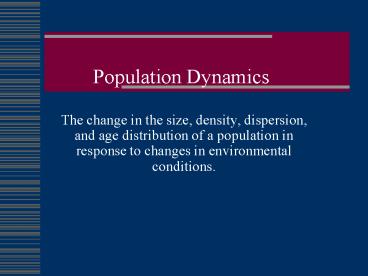Population Dynamics - PowerPoint PPT Presentation
1 / 24
Title:
Population Dynamics
Description:
Population Dynamics The change in the size, density, dispersion, and age distribution of a population in response to changes in environmental conditions. – PowerPoint PPT presentation
Number of Views:346
Avg rating:3.0/5.0
Title: Population Dynamics
1
Population Dynamics
- The change in the size, density, dispersion, and
age distribution of a population in response to
changes in environmental conditions.
2
Healthy Populations
- A healthy population will grow and die at a
steady rate unless it runs out of food or space
or is attacked by disease or predators.
3
How are populations studied?
- Introduced into study areas with abundant
resources. - Tracked in their natural environment.
- Population Counts Determine if a population is
healthy and growing. - Population Density Population per Area
4
What difficulties can occur when trying to
measure a wildlife population?
- Wildlife can look alike, move, and hide resulting
in animals being missed or counted more than once.
5
So, how do you measure a population?
- Trap-Mark-Release
- Animals are trapped, marked, and released and
then trapped a second time. - By comparing the number of marked and unmarked
animals in the second sampling, the population
size can be estimated.
6
So, how do you measure the size of a population?
- Sample Counts
- Used to estimate the size of a population
scattered over a large area by sampling a smaller
area.
7
How fast do populations grow?
- Population size is affected by the birth rate,
death rate, immigration rate, and emigration rate
of a population. - Birth Rate Immigration gt Death Rate
Emigration Increase - Birth Rate Immigration lt Death Rate
Emigration Decrease
8
Population Curves
- A population curve graphs the size of a
population (number of individuals) on the y-axis
over time on the x-axis.
9
Population Growth
- Populations show exponential growth, not linear
growth. - The population growth starts out slow and then
increases rapidly with the increasing population
size until the carrying capacity is reached. - Unlimited exponential growth results in an
J-shaped population curve.
10
(No Transcript)
11
Carrying Capacity (K)
- The largest number of individuals of one species
that an ecosystem can support indefinitely. - When a population reaches carrying capacity, some
organism must either die off or find new
resources.
12
Temporary Overshoot of Carrying Capacity
- Before a population reached carrying capacity, it
is not affected by limiting factors and can grow
exponentially and can overshoot the carrying
capacity.
13
Temporary Overshoot of Carrying Capacity
- After the carrying capacity is exceeded, the
resources for the population are limited and
unless other resources are found, the population
will suffer a crash and fall to a new lower carry
capacity for the population. - This results in an S-shaped population curve.
14
Life-History Pattern
- An organisms reproduction pattern.
- Can vary between two extremes.
- Rapid life-history patterns
- Slow life-history patterns
15
Slow Life History Patterns
- Produce a few, often large offspring, which they
care for over a long period of time. - Maintain stable population sizes near the
carrying capacity. - Populations typically follow an S-shaped curve.
16
Rapid Life History Patterns
- Have a high rate of population growth (r) (Many
offspring in a short time period.) - Reproduce hordes of offspring early in life.
- Offspring are usually small, short-lived, and
mature rapidly with little to no parental care.
17
Rapid Life History Patterns
- Usually opportunists, reproducing rapidly when
conditions are favorable and crashing when
conditions are not. - Examples insects, rodents, bacteria
18
Biotic Potential
- Highest rate of reproduction under idealistic
conditions. - The larger the number of offspring produced by
parent organisms, the higher the biotic potential
of the species.
19
Limiting Factors and Dispersal
- 3 Patterns of Dispersal
- Random
- Clumped (most common)
- Uniform (least common)
20
Population Controls
- Density-dependent Population Controls
- Limiting Factors which become more influential as
the population increases. - Examples disease, competition, predators
- Density-independent Population Controls
- Effect population regardless of population size
or dispersal. - Examples temperature, storms, drought
21
How do interactions between organisms limit
population size?
- Predator-Prey Relationships
- Predators limit the size of prey populations,
which can then limit the size of the predator
population. - Competition
- Usually the most intense within the same species.
- Overcrowding and Stress
22
Human Populations
- Demography
- The study of human population size, density and
distribution, movement, and birth and death
rates. - Doubling Time
- The time needed for a population to double in
size.
23
Human Populations
- Age Structure
- The proportions of the population that are in
different age levels. - Can be used to determine stability.
24
Will humans ever reach their carrying capacity?

